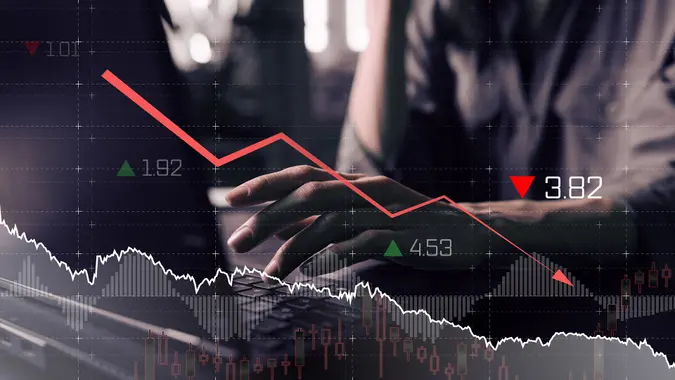10 Best Growth Stocks To Buy in 2023

Commitment to Our Readers
GOBankingRates' editorial team is committed to bringing you unbiased reviews and information. We use data-driven methodologies to evaluate financial products and services - our reviews and ratings are not influenced by advertisers. You can read more about our editorial guidelines and our products and services review methodology.

20 Years
Helping You Live Richer

Reviewed
by Experts

Trusted by
Millions of Readers
Growth investors are inspired by those who got in early on the stocks that would dominate the 21st century — Google, Facebook, Amazon and the rest. Unlike slow and steady value stocks and income-generating dividend stocks, growth stocks have the potential for upward trajectories that deliver three, four, five and even six-figure percentage gains.
But they also come with greater risks and special considerations. Here’s what you need to know about investing in growth stocks.
What Is Considered a Growth Stock?
Growth stocks are companies that fatten their revenues, profits and share prices much faster than the market as a whole. Growth stocks tend to be small, emerging, disruptive companies that threaten old and entrenched industry players.
Sometimes, they create a brand new product, service or idea, like Uber or Airbnb. In other cases, they take an existing idea and create new ways to scale it. Starbucks, for example, was hardly the country’s first coffee shop. But the company’s game-changing branding, marketing and product line made Starbucks a fixture in cities and towns across the country.
What Is a Growth Stock Example?
In the 21st century, the best examples of growth stocks have come out of the tech industry. Companies like Amazon and Facebook have emerged as fledgling startups in a crowded field before roaring to the top of the S&P 500.
Growth stocks tend to be more expensive than other stocks because of their potential for outsized gains. Value stocks, on the other hand, are covered for being underpriced.
Another hallmark of growth stocks is that they don’t pay dividends, or pay only nominal dividends. Instead of making periodic payments to their shareholders, growth companies reinvest every available dollar back into the company to grow it as aggressively as possible. That could mean investments in new technology, physical expansion, hiring, acquiring other businesses or accelerating production.
The tradeoff is heightened risk — that strategy makes growth stocks much more susceptible to steep losses during market downturns.
What Are the 10 Best Growth Stocks To Buy Right Now?
Here is a look at some of the best growth stocks of 2023, as well as their return on equity. ROE is a measure of how efficiently a company generates profits and can be calculated by dividing net income by shareholder equity.
| Company Name and Ticker Symbol | Return on Equity |
|---|---|
| T-Mobile US Inc. (TMUS) | 5.50% |
| Tesla (TSLA) | 27.90% |
| Core & Main (CNM) | 22.70% |
| MercadoLibre, Inc. (MELI) | 16.40% |
| Alphabet Inc. (GOOG, GOOGL) | 22.84% |
| Amazon (AMZN) | 3.00% |
| Halliburton (HAL) | 25.20% |
| Arcos Dorados (ARCO) | 55.20% |
| Meta Platforms Inc. (META) | 17.10% |
| Delta Airlines (DAL) | 35.70% |
What Is the Best Growth Stock?
A lot of growth stocks have made a lot of people rich. If you had to pick one of the best growth stocks in the modern era, no one could blame you for guessing Apple, Google, Amazon or Netflix. But sometimes, under-the-radar stocks quietly turn their shareholders into millionaires while the big headline-grabbing companies gobble up all the attention.
In this case, it’s hard to argue that Monster Beverage (MNST) hasn’t been one of the best, if not the best, growth stock of the last quarter-century. Since it launched its IPO in 1995, the one-time penny stock had generated total returns of more than 260,000% by July 2022, according to U.S. News & World Report, making it the best-performing stock on the S&P 500 in the last three decades.
The trick, however, was to get in on the action in the mid-to-late ’90s before the secret was out. The thing about growth stocks is that a company can only grow so big. After a mad dash to the top, all growth stocks eventually level off.
The Potential for Outsized Gains Comes With Greater Risk
While growth stocks offer the chance at big gains, the tradeoff for a greater reward is always a greater risk. As previously stated, growth companies reinvest most of their cash in the pursuit of massive revenues, profit growth and price appreciation.
This is a risky strategy that makes growth stocks susceptible to volatility, market downturns and internal problems.
When the market is up, growth stocks tend to outperform. But when the tides reverse and the market turns bear, growth investors often shoulder a disproportionate amount of pain. The tech-heavy growth stocks on the NASDAQ significantly outperformed during the previous decade’s bull market, but they also incurred much greater losses during the downturn of 2022.
Amazon might just be the market’s most famous growth stock. It delivered an incredible return of roughly 1,500% during the 2010s, with investors gaining 65% between 2020-2021 alone. But that’s after it reached maturity. According to Forbes, the company shed a full 90% of its value during the dotcom bust, and it took nearly a decade for Amazon to recover.
Growth stocks also commonly forgo profits in the pursuit of rapid gains and expansion. Founded in 1996, Amazon didn’t record its first profitable year until 2003.
How To Find the Next Big Stock
A stock’s success is not always dependent on how big or influential a company is. It also has a lot to do with the current trends. Companies that capitalize on these trends generate more wealth and value for shareholders.
The COVID-19 pandemic was a case study of how societal changes can crack the door enough for the right growth stocks to bust out:
- E-commerce: With lockdown restrictions in place, people predominantly shopped online. This raised the stock prices for companies like Shopify and Amazon.
- Digital Advertising: As more companies started operating online, the need for digital advertising grew. Companies like Alphabet and Facebook profited from this trend.
- Streaming Services: Since the whole world was under quarantine, the need for at-home entertainment grew. Therefore, streaming services like Netflix, Amazon Prime and HBO Max saw a rise in revenue generation.
- Remote Work: The pandemic also shifted in-person work and education to remote or hybrid models. That increased the need for video calling and collaboration services like Zoom, Skype and Google Classroom.
Trends To Watch in 2023
With Americans working and learning in person again and stock prices reflecting fears of a recession, the investing landscape has changed over the past year. Fidelity has identified several areas of opportunity for 2023:
Healthcare
People need medical care regardless of what the market is doing, which makes healthcare a good choice for defensive investing. The sector has outperformed the overall market over the past year.
Consumer Staples
Consumer staples — products and services you can’t live without — are another defensive sector. Staples to watch this year include food and beverages, personal health and hygiene and tobacco.
Consumer Discretionary
Some analysts worry that the Fed’s rate hikes will cause a recession. This would discourage consumers from making discretionary purchases. However, if inflation continues to decline and the U.S. avoids recession, discretionary stocks such as retail apparel, home-improvement, leisure and travel stocks could see significant growth.
Industrials
Renewed focus on domestic manufacturing could drive growth in industrial stocks this year. Although the industrial sector has had major obstacles over the last few years and could face more in 2023, Fidelity analysts see strong long-term opportunities for companies that invest in digitization and sustainability.
Go For Growth — But Do It Carefully
When you include growth stocks in your portfolio, consider the heightened risk they present and mitigate that risk by including safer bets like dividend stocks and value stocks. According to Forbes, you should use P/E ratio analysis to seek out growth stocks that are already turning a profit. They tend to offer more stability than those that aren’t yet making any money. Also, avoid companies with a lot of debt on their balance sheets and stick with growth stocks with debt-to-equity ratios under 30%.
Scott Jeffries and Daria Uhlig contributed to the reporting for this article.
Data is accurate as of May 8, 2023, and subject to change.
Our in-house research team and on-site financial experts work together to create content that’s accurate, impartial, and up to date. We fact-check every single statistic, quote and fact using trusted primary resources to make sure the information we provide is correct. You can learn more about GOBankingRates’ processes and standards in our editorial policy.
- NewScientist. 2021. "Why Has Facebook Changed Its Name to Meta and What Is the Metaverse?"
- Nasdaq. 2022. "Is It Too Late to Buy Shopify Stock?"
- BigCommerce. 2021. "BigCommerce Announces Third Quarter Financial Results."
- Business Insider. 2020. "Duolingo Sees Spike in New Users During Coronavirus Pandemic."
- Reuters. 2021. "Facebook Benefits From Pandemic Ad Spending but Apple Could Spoil Its Party."
- NPR. 2020. "Zoom Turns Record Profit Thanks To Coronavirus Shutdowns."
- Forbes. 2022. "Despite Recent Headwinds, Shopify Stock Looks Like A Buy At $1,220."
- Forbes. 2022. "Invest In Growth Stocks."
- U.S. News. 2022. "10 Best-Performing Stocks of the Past 30 Years."
- Morgan Stanley. 2022. "Is Now the Time to Buy the Market Bottom?"
- Fidelity. 2022. "Health care: Short-term defense, long-term growth potential."
- Fidelity. 2022. "Industrials: A new dawn for US manufacturing?"
 Written by
Written by  Edited by
Edited by 

























